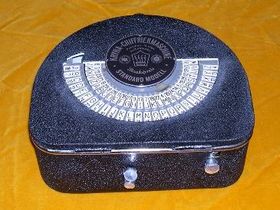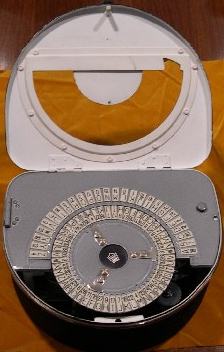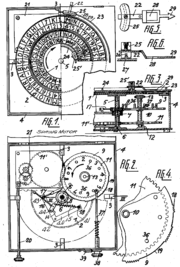
Kryha
Encyclopedia

History of cryptography
The history of cryptography begins thousands of years ago. Until recent decades, it has been the story of what might be called classic cryptography — that is, of methods of encryption that use pen and paper, or perhaps simple mechanical aids...
, the Kryha machine was a device for encryption and decryption, appearing in the early 1920s and used until the 1950s. The machine was the invention of Alexander von Kryha (born 31.10.1891 in Charkow, Ukraine
Ukraine
Ukraine is a country in Eastern Europe. It has an area of 603,628 km², making it the second largest contiguous country on the European continent, after Russia...
, committed suicide in Baden-Baden
Baden-Baden
Baden-Baden is a spa town in Baden-Württemberg, Germany. It is located on the western foothills of the Black Forest, on the banks of the Oos River, in the region of Karlsruhe...
in 1955). During the Second World War, Kryha worked as an officer for the German Wehrmacht
Wehrmacht
The Wehrmacht – from , to defend and , the might/power) were the unified armed forces of Nazi Germany from 1935 to 1945. It consisted of the Heer , the Kriegsmarine and the Luftwaffe .-Origin and use of the term:...
. There were several versions; the standard Kryha machine weighed around five kilograms, and was totally mechanical. A scaled down pocket version was introduced later on, termed the "Lilliput" model. There was also a more bulky electrical version.
The machine was used for a time by the German Diplomatic Corps, and was adopted by Marconi in England
England
England is a country that is part of the United Kingdom. It shares land borders with Scotland to the north and Wales to the west; the Irish Sea is to the north west, the Celtic Sea to the south west, with the North Sea to the east and the English Channel to the south separating it from continental...
.
Operation

Concentric
Concentric objects share the same center, axis or origin with one inside the other. Circles, tubes, cylindrical shafts, disks, and spheres may be concentric to one another...
rings each containing an alphabet
Alphabet
An alphabet is a standard set of letters—basic written symbols or graphemes—each of which represents a phoneme in a spoken language, either as it exists now or as it was in the past. There are other systems, such as logographies, in which each character represents a word, morpheme, or semantic...
. The inner alphabet was stepped a variable number of places by pushing a lever. In operation, the user would encrypt by finding the plaintext
Plaintext
In cryptography, plaintext is information a sender wishes to transmit to a receiver. Cleartext is often used as a synonym. Before the computer era, plaintext most commonly meant message text in the language of the communicating parties....
letter on one ring (usually the outer ring), and reading the corresponding letter on the other ring; this was then used as the ciphertext letter. When the lever was pressed, the inner ring would step, causing the relationship between the two alphabets to change. The stepping was irregular and governed by the use of a disk with a number of sectors, each containing a number of teeth.
Cryptanalysis

Georg Hamel
Georg Karl Wilhelm Hamel was a German mathematician with interests in mechanics, the foundations of mathematics and function theory....
, who calculated the size of the key
Key (cryptography)
In cryptography, a key is a piece of information that determines the functional output of a cryptographic algorithm or cipher. Without a key, the algorithm would produce no useful result. In encryption, a key specifies the particular transformation of plaintext into ciphertext, or vice versa...
space. The US Army was also contacted to see if they would be interested in using the machine, and were persuaded to accept a challenge message to evaluate the security of the device. The challenge message, 1135 characters long, was solved by William Friedman, assisted by Solomon Kullback
Solomon Kullback
Solomon Kullback was an American cryptanalyst and mathematician, who was one of the first three employees hired by William F. Friedman at the US Army's Signal Intelligence Service in the 1930s, along with Frank Rowlett and Abraham Sinkov. He went on to a long and distinguished career at SIS and...
, Frank Rowlett
Frank Rowlett
Frank Byron Rowlett was an American cryptologist.Rowlett was born in Rose Hill, Virginia and attended Emory & Henry College in Emory, Virginia, where he was a member of the Beta Lambda Zeta fraternity. In 1929 he received a bachelor's degree in mathematics and chemistry...
and Abraham Sinkov
Abraham Sinkov
Dr. Abraham Sinkov was a US cryptanalyst.-Biography:Sinkov, the son of immigrants from Russia, was born in Philadelphia, but grew up in Brooklyn. After graduating from Boys High School—what today would be called a "magnet school" -- he took his B.S. in mathematics from City College of New York...
, in 2 hours and 41 minutes.
External links
- Jerry Proc's pages on the Kryha: Standard, Electrical and Lilliput.
- Standard Kryha: Machine cover open and Machine cover closed
- Nick Gessler's page on the Kryha: Photographs

